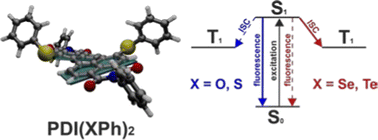Excited states and spin–orbit coupling in chalcogen substituted perylene diimides and their radical anions†
Abstract
While spin–orbit coupling does not play a decisive role in the photophysics of unsubstituted perylene diimides (PDI), this changes dramatically when two phenylselenyl or phenyltelluryl substituents were attached to the PDI bay positions. In the series of PhO-, PhS-, PhSe-, and PhTe-substituted PDIs we observed strongly decreasing fluorescence quantum yield as a consequence of strongly increasing intersystem crossing (ISC) rate, measured by transient absorption spectroscopy with fs- and ns-time resolution as well as by broadband fluorescence upconversion. Time-dependent density functional calculations suggest increasing spin–orbit coupling due to the internal heavy-atom effect as the reason for fast ISC. In case of the selenium PDI derivative we found significant singlet oxygen sensitization via the PDI triplet state. The corresponding radical anions of the chalcogen substituted PDIs were also prepared and investigated by optical and EPR spectroscopy. Here, the increasing SOC results in an increase of the g-tensor anisotropy, and of the isotropic g-value in solution, albeit quasirelativistic density functional calculations show only a relatively small fraction of the spin density to be located on the chalcogen atom.



 Please wait while we load your content...
Please wait while we load your content...